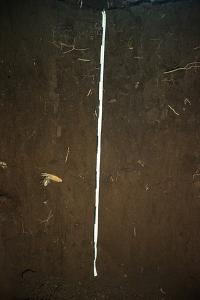Reference soil Kenya 44: Nitisol
Nitisols occur mainly in the tropics and subtropics, as well as in areas with a Mediterranean type of climate. They are associated with basic rocks (e.g. basalts) or hard limestone or dolomite deposits.
Characteristics
Soils having a nitic horizon (a horizon with pronounced nut-shaped soil structure and significant amount of active iron) within 100 cm from the soil surface, and gradual to diffuse horizon boundaries between the surface and the underlying horizons. They do not have a ferric, plinthic or vertic horizon within 100 cm from the soil surface.
Reference soil KE044: Nitisols
Brief soil description: Very deep, well drained soil derived from basic volcanic breccia; with a thick, dusky red clay topsoil over a dark brown, clay subsoil with clay cutans. The soil is used for arable farming with crops as coffee, maize, bananas and cassava. Charcoal and potterie are found troughout the 0 - 80cm soil hrizon Termite activity is very high. Slides: 10,052 - 10,059.
